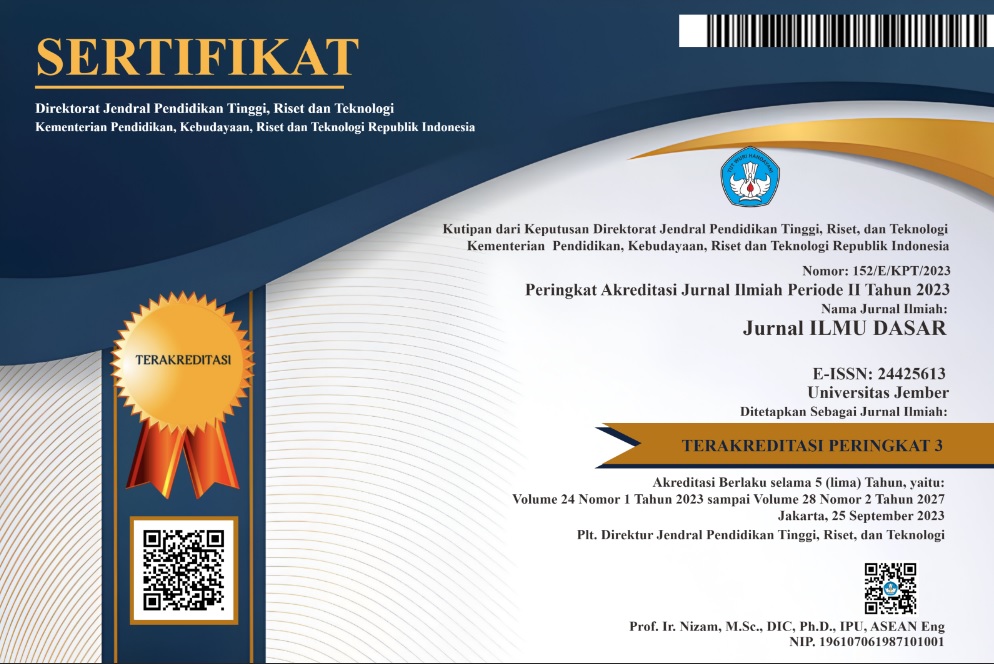Classification of Malignancy of Lung Cancer Using Backpropagation Algorithm on CT-Scan Images
DOI:
https://doi.org/10.19184/jid.v25i2.39054Keywords:
Lung cancer, image classification, GLCM, backpropagationAbstract
In this study, we investigate the classification of lung cancer CT scan images based on malignancy level using a backpropagation artificial neural network (ANN). Lung cancer is a deadly disease characterized by the growth of abnormal lung cells. The proposed method involves preprocessing to enhance image quality, followed by feature extraction using the Gray Level Co-occurrence Matrix (GLCM) method with angle variations of 0°, 45°, 90°, 135°, and d=1. The extracted features include energy, contrast, correlation, and homogeneity. The energy value range in malignant cancer is 0.27 to 0.81, while in benign cancer it is 0.26 to 0.73. The contrast in benign cancer ranges from 1.38 to 11.87, while in malignant cancer it is 1.47 to 13.67. The image correlation for malignant cancer is between 0.63 to 0.94, while for benign cancer it is 0.69 to 0.96. Homogeneity in malignant cancer has a value range between 0.67 to 0.91, while in benign cancer it ranges from 0.70 to 0.92. The classification of lung cancer malignancy is restricted to benign and malignant levels using a network architecture of [4 10 2], maximum iteration of 100000, and learning rate of 0.001. The accuracy of the testing data from the ANN is between 90% and 100%. These results demonstrate the effectiveness of the GLCM method and backpropagation algorithm in accurately classifying the malignancy level of lung cancer, which could aid in the early detection and treatment of the disease.
Downloads
References
Andayani U, Rahmat RF, Syahputra MF, Lubis A & Siregar B. 2019. Identification of Lung Cancer Using Backpropagation Neural Network. Journal of Physics: Conference Series. 1361(1).
Anraeni, Siska & Herman. 2018. Peningkatan Kualitas Citra Iris Mata Menggunakan Operasi Piksel Dan Ekualisasi Histogram Untuk Pengklasifikasian Kondisi Kesehatan Ginjal. Seminar Nasional Teknologi Informasi dan Komunikasi STI&K (SeNTIK). 2: 1-6.
Dijaya R. 2023. Buku Ajar Pengolahan Citra Digital. Sidoarjo: UMSIDA Press.
Globocan. 2020. Cancer in Indonesia.
Heryanto, Agus IW, Artama, Kurniawan MWS & Gunadi GA. 2020. Segmentasi Warna dengan Metode Thresholding. Wahana Matematika dan Sains. 14(1): 54-64.
Lamasigi & Yusrin Z. 2021. DCT untuk Ekstraksi Fitur Berbasis GLCM pada Identifikasi Batik Menggunakan K-NN. Jambura Journal of Electrical and Electronics Engineering. 3(1): 1-6.
Lucas RM & Harris RMR. 2018. On The Nature of Evidence and ‘Proving’ Causality: Smoking and Lung Cancer vs. Sun Exposure, Vitamin D and Multiple Sclerosis.†International Journal of Environmental Research and Public Health. 15(8): 1-13.
Makaju S, Prasad PWC, Alsadoon A, Singh AK & Elchouemi A. 2018. Lung Cancer Detection using CT Scan Images. Procedia Computer Science. 125(2009): 107-114.
Saitem, Adi K & Widodo E. 2016. Analisis Citra CT Scan Kanker Paru Berdasarkan Ciri Tekstur Gray Level Co-occurrence Matrix dan Ciri Morfologi Menggunakan Jaringan Syaraf Tiruan Propagasi Balik. Youngster Physics Journal. 5(4): 417-424.
Shankara C & Hariprasad SA. 2022. Artificial Neural Network for Lung Cancer Detection Using CT Images. International Journal of Health Sciences. 6(March): 2708-2724.
Silvana, Meza, Akbar R, Gravina H & Firdaus. 2020. Optimization of characteristics using Artificial Neural Network for Classification of Type of Lung Cancer. 2020 International Conference on Information Technology Systems and Innovation, ICITSI 2020 - Proceedings. 236-241.
Soeroso NN, Soeroso L & Syaï¬uddin T. 2014. Kadar Carcinoembryogenic Antigen (CEA) Serum Penderita. J Respir Indo. 34(1): 17-25
Sumijan S, Purnama AW & Arlis S. 2019. Peningkatan Kualitas Citra CT-Scan dengan Penggabungan Metode Filter Gaussian dan Filter Median. Jurnal Teknologi Informasi dan Ilmu Komputer. 6(6): 591-600.
Yulianti D, Nurhasanah & Arman Y. 2021. Segmentasi Citra Sel Darah Serviks. Prisma Fisika. 9(1): 1-3.








